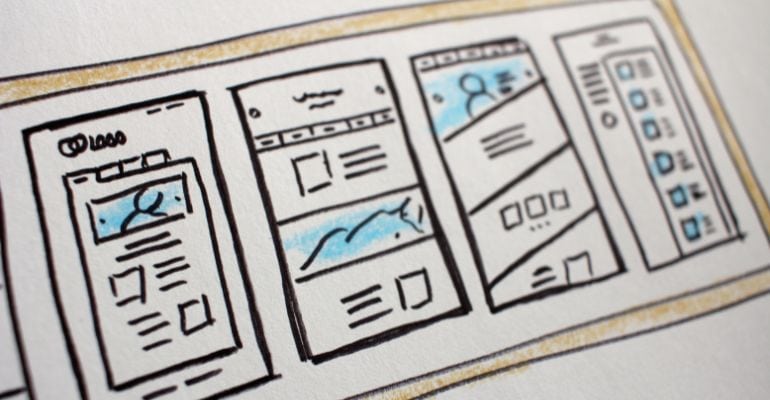Websites are a critical piece of the buyer journey today. What do most people do if they want to find something out or get a recommendation? They turn to the internet. But it’s not enough to simply have a presence. We’ve moved on from clunky, hard to navigate websites. Your audience expects an easy user experience that gives them exactly what they’re searching for.
This presents a huge opportunity for businesses. Your website can do a lot of the heavy lifting for you. It can automate some, if not all, of your buyer’s journey and free up vital resources to be reallocated.
But if your website isn’t optimised for conversions, you’re missing out on those opportunities for new people to find you and anyone to buy from you. Moreover, if you’re also paying for traffic, you’re basically throwing away money.
So what makes a high converting website? We’re going to dive into 10 website must-haves that will help you turn visitors into paying customers.
First Impressions
We’ve split our top 10 must-haves into 2 sections: First Impressions and Diving Deeper. The elements under First Impressions cover the aspects of your website that are immediately obvious to your audience, and therefore impact whether they stay on your website or not.
1. Clean Design with a User-Friendly Interface
Your website is the virtual storefront for your trades and construction business, and a visually appealing website design reflects professionalism and conveys trust and reliability. If your audience is immediately faced with a messy and dated design, they’re likely to leave your website without diving deeper.
Tips for a Visual Appealing Website:
- Choose a cohesive colour scheme that aligns with your brand identity.
- Opt for high-quality images and graphics relevant to your industry.
- Ensure a balance between text and visuals for a clean and organised look.
- Keep the design distraction free – keep pop ups, extra links, and distracting elements to a minimum.
- Have a maximum of 6 links on your navigation menu. (You can always add sub links under those main headings if you need them.)
2. Mobile Responsiveness
Due to the size and ratio of a phone screen, websites on mobiles look different. While your website automatically reformates your website for a mobile, it’s often unoptimized if you don’t make any mobile-only adjustments.
This means that elements within sections might appear out of order, images can be too large/small, your font size is incorrect, and navigation is difficult, alongside many more ‘errors’. Forgetting about/ignoring mobile responsiveness is not acceptable when 9 in 10 internet users access the internet using a mobile phone. The amount of monthly cellular data consumed has increased 1280% since 2017, and this will continue to grow.
3. Attention Grabbing Headlines
The power of a compelling headline cannot be overstated. Headlines serve as the first point of contact with your audience, and their effectiveness can determine whether visitors delve deeper into your content or move on.
Attention spans are limited online, and visitors often engage in skim reading. A well-crafted headline can persuade users to explore your content further.
Tips for Attention Grabbing Headlines:

- Clarity and Relevance: Clearly convey the purpose or benefit of the content.
- Intriguing Language: Use words that pique curiosity or evoke emotion.
- Problem-Solution Approach: Highlight how your content addresses a specific challenge or need.
- Subheadings: If you feel the need to provide more important information, include it as a subheader so your header text doesn’t run on.
- Consistent Tone: Maintain a consistent tone that aligns with your brand and resonates with your target audience.
4. Speed and Performance
40% of people will abandon a website if it takes more than 3 seconds to load. Speed is a critical factor that directly influences user satisfaction and conversion rates. Not only that, search engines prioritise fast-loading websites, contributing to higher visibility. When it comes to trades and construction business websites, where information is often sought quickly, fast-loading pages are non-negotiable.
Tools for Website Speed Optimization:
- Google PageSpeed Insights: Evaluate your website’s performance and receive suggestions for improvement.
- GTmetrix: Analyse your site’s speed and receive actionable recommendations.
- Pingdom: Test your website’s load time and identify bottlenecks affecting performance.
Techniques for Website Speed Enhancement:
- Optimise Images: Compress and format images to reduce file sizes without compromising quality.
- Browser Caching: Enable caching to store elements of your site locally, reducing load times for returning visitors.
- Minimize HTTP Requests: Reduce the number of elements on a page, such as scripts and stylesheets, to speed up loading.
5. Integration of Multimedia
Multimedia elements, such as images and videos, play a critical role in capturing the attention of your audience in the trades and construction industry.
The visual appeal and interactive nature of multimedia not only make your website more engaging, but also convey information in a dynamic and memorable way. Complex construction processes or intricate details can also be better communicated through visual media.
Once again, search engines often favour content with multimedia elements, potentially improving your website’s visibility. But don’t just do it to please the algorithm. Ensure that all multimedia enhance, rather than detract from, the user experience.
Diving Deeper

The following elements are strategies to increase conversions now that your audience has decided to explore your website in more detail.
6. Clear Call-to-Action (CTA)
Calls to Action (CTA) direct your audience to take action; for example, “Get Your Free Estimate Today!” and “Start Building Your Dream Home”. Strategic placement of clear and visually appealing buttons is essential, because visitors are more likely to take action when presented with a clear and accessible CTA.
Ensure that a compelling CTA is prominently featured on every page of your trades and construction business website. You want every page of your website to be a potential entry for conversion.
Design-wise, make your CTAs resemble buttons rather than linked text. Button-style CTAs are more visually recognisable and instinctively clickable, which will help increase your conversion rates.
Elements of Effective CTA Copy:
- Clarity: Clearly convey what action the user is expected to take.
- Urgency: Instill a sense of urgency to prompt immediate action.
- Value Proposition: Highlight the benefits or value users gain by clicking on the CTA.
- Action Words: Use verbs that encourage action, such as “Get,” “Discover,” or “Start.”
7. Trust-Building Elements
People buy from people they trust. One way to build trust is sharing testimonials and case studies. Testimonials showcase satisfied clients, offering social proof of your business’s reliability. Prospective clients can also relate to the experiences of others, fostering trust and confidence.
Taking this to the next level, case studies delve into the specifics of successful projects, demonstrating your expert skills and problem-solving abilities. This sets you apart from your competition.
Trust badges and certifications are also useful trust building elements, as they serve as visual indicators of your business’s credibility and compliance with industry standards. In the trades and construction sector, displaying relevant badges can significantly influence a visitor’s perception.
8. High-Quality Content
Your potential clients come to your website seeking answers, solutions, and valuable information. Crafting content that bridges the gap between their queries and your offerings is key. This means understanding the difference between what prospects need to know to go from consideration to purchase, and what you want to tell them.
Also consider how SEO plays into your content strategy, by including keywords relevant to your trades and construction business. This will strategically enhance your website’s visibility, making it easier for your target audience to find you. Be sure to seamlessly integrate keywords into your content to maintain readability. Your website should be written to real people, not search engines.
Key Aspects of Audience-Centric Content:
- Problem-Solving Approach: Address common challenges or questions your audience may have.
- Clear Communication: Present information in a straightforward manner, avoiding unnecessary jargon.
- Relevance: Align content with the needs and interests of your target audience.
- Provide Educational Resources: Informative articles, guides, or tutorials that address common concerns.
9. Contact Page
The Contact Page acts as a direct line of communication between your business and potential clients. In the trades and construction industry, where projects often require personalised discussions, providing a straightforward means of contact is crucial.
You want to make it as easy as possible for your target audience to contact you. If you make it difficult (this also includes too many steps), they’ll go to your competitors. Ensure your contact page is easy to find on your website, and any forms are user-friendly and request only essential information to streamline communication.
10. Lead Capture Forms
Lead capture forms are instrumental in converting website visitors into potential clients for trades and construction businesses. They’re similar to forms on contact pages, but often sit on homepages or alongside information about specific services.
Optimising these forms for easy completion and minimising form fields are essential strategies for maximising conversions.
Tips to Increase Lead Capture Form Conversions
- Have a Logical Flow: Organise form fields in a logical order to guide users through the process.
- Use Clear Labels: Use clear and concise labels for each form field to avoid confusion.
- Smart Defaults: Pre-fill fields with known information when possible for a smoother experience.
- Time Indicators: For longer forms, consider incorporating progress indicators to give users a sense of how much form remains.
Unlock the Power of Your Website
Your website is the digital gateway to your trades and construction business. It’s a powerful tool capable of automating crucial aspects of the buyer’s journey, freeing up resources and amplifying your business’s reach.
It’s evident that the digital era demands more than clunky, hard-to-navigate websites. Your audience seeks an effortless user experience, an experience that aligns with their needs and expectations.
The opportunities are vast for businesses ready to harness the potential of their websites. You need to prioritise this element of your business and respect it as the powerful marketing and sales tool it is.
By implementing these 10 must-haves, you’re not just creating a website; you’re crafting a digital experience that resonates, engages, and converts. Unlock the full potential of your online presence, and let your website become a driving force in your business’s success!
Power to you,
Stefan Kazakis,
Founder & CEO, Business Benchmark Group






